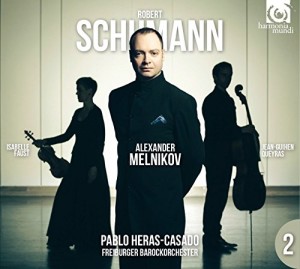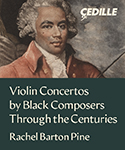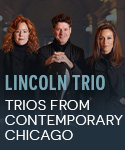In 2015 pianist Alexander Melnikov, violinist Isabelle Faust, and cellist Jean-Guihen Queyras launched a cycle devoted to Schumann’s complete concertos and trios performed on period instruments. This second volume contains the Piano Concerto and the Trio No. 2 in F major. A blurb on the back of the jacket claims that this recording shows “just how badly we need an interpretation that respects the subtleties and the transparency of Schumann’s writing.” As if no other recordings have done so? The Abegg Trio, the Florestan Trio, the Beaux Arts Trio in Op. 80? And the concerto. Are not Perahia/Abbado, Moravec/Neumann, Janis/Reiner, Fleisher/Szell, and Howard Shelly conducting from the piano sufficiently subtle and transparent?
Let’s discuss the concerto first. The Freiburger Barockorchester’s reduced forces bring the winds and brass in line with the strings, and you hear much more timpani than usual. The first movement succeeds best. Melnikov launches into his opening flourish in strict tempo, without yielding an inch. Then Melnikov and conductor Pablo Heras-Casado reveal their effectively affetuoso agenda, stretching transitional passages to their limits, tapering phrases, and uncovering inner voices that rarely get airplay. In addition, the dry, biting quality of Melnikov’s 1837 model Erard gives rapid accompanimental passages an uncommonly clear, bristling quality.
However, the perfunctory Intermezzo gives little hint of Schumann’s “grazioso” directive in the conversational piano/orchestra exchanges. The finale simply flops; it’s slow, square, low-energy, joyless, and anything but a bona fide Allegro vivace. Watching this movement on the supplementary DVD, I was amused to see soloist and conductor grimacing, as if they were in pain.
Fortunately, the F major Trio is on an altogether higher level. The musicians’ finely tuned synchronicity and fervent yet controlled response to the composer’s sudden dynamic and mood shifts underscores Schumann’s restless creativity. And they really listen to each other. For example, the melodic lines in the opening of the second movement are close in register and often interpreted in an amorphous, generalized manner, with little sense of conversational repartée, but not here. My ears also perked up during the third movement, where the slow and potentially jerky dotted rhythms are inflected and characterized with subtly varied tonal gradations. Our final performance rating, therefore, is a compromise, splitting the difference between 6 for the concerto and 10 for the trio.
































